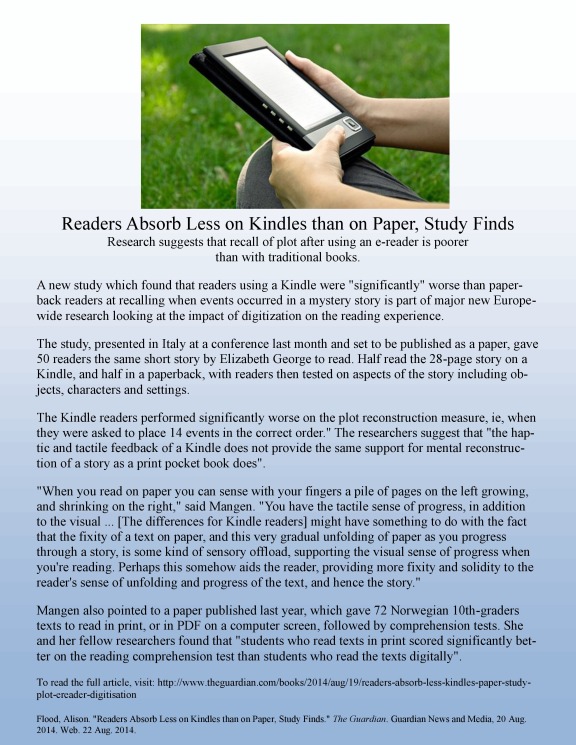
American university students this spring still are using printed textbooks far more than eTexts. In 2010, it was predicted eTexts would rise from 2 percent of college course materials to more than 18 percent after 2014. It didn’t happen.
In the study “Student Reading Practices in Print and Electronic Media” to be published in the journal College & Research Libraries in September 2014, researchers tracked the reading habits of juniors, seniors and graduate students at the College of New York. Although students used electronic media for non-academic reading, they relied on paper for academics.
There are “a lot of misconceptions about millennials” as a digital generation, according to researcher Nancy Foasberg who led the study. The Chronicle of Higher Education reported on Foasberg’s research: “Several students in Ms. Foasberg’s study expressed a distaste for digital textbooks. Some who had used e-books said they would not use them again because they found the embedded links distracting and because they could not interact with the content as they could with print texts — highlighting or taking notes in the margins, for instance. And since the students found themselves printing out digital texts, whatever money they had saved by not buying printed copies was largely lost to printing costs.”
Another writer, Ferris Jabr, details the extensive research during the last two years that confirms the science behind students’ intuitive preference for printed text. In the November issue of Scientific American, Jabr lays out the shortcomings of reading from screens in “Why the Brain Prefers Print.” Summarizing recent research from Tufts University, Indiana University, University of Stavanger (Norway), Karlstad University (Sweden), Technion-Israel Institute of Technology, University of Leicester, University of Central Florida and San Jose State University, the downsides of reading on-screen are piling up.
Research indicates the brain treats words as physical objects which have a placement on a page but are fleeting on screen. Measures of brain activity are high when a student writes letters by hand, but not when they are typed. Many of us experience “drifting away” while scrolling. Research shows scrolling promotes shallow reading and reduces comprehension. Text provides us with both “deep reading” and context.
Reading printed text is “less taxing cognitively” and provides us with “more free capacity for comprehension.” Reading on the Kindle “ink” format that imitates paper is less taxing than reading the backlit screens of other readers, cellphones, tablets and computer screens. Indeed, most readers report higher levels of stress, eye strain and scrolling that “drains more mental resources.”
Researchers found screens promote browsing, taking shortcuts and scanning. Readers of print are much more likely to re-read and check for understanding.
For college students, the bottom line is: “Will the format affect my test scores?” Researchers found “volunteers using paper scored about 10 percentage points higher … students using paper approached the exam with a more studious attitude than their screen-reading peers.” Under both modes, students could superficially “remember,” but those studying printed text “knew with certainty,” a trait likely related to the deep-reading of print.
Will the next “digital generation” avoid this difference and be better adapted to screens? Even with young children, researchers found the screens got in the way. Children were distracted into fiddling with the knobs on the device and otherwise being distracted by the technology.
Despite a decade of hype, American college students appear to agree with the survey of students at the National Autonomous University of Mexico where 80 percent of students preferred print to screen in order to “understand with clarity.”
John Richard Schrock is a professor in the Department of Biological Sciences at Emporia State University.
Article taken from: http://hdnews.net/opinion/schrock021714
So do not wait! Contact The P.A. Hutchison Company to get your printed order in today!
0.000000
0.000000










